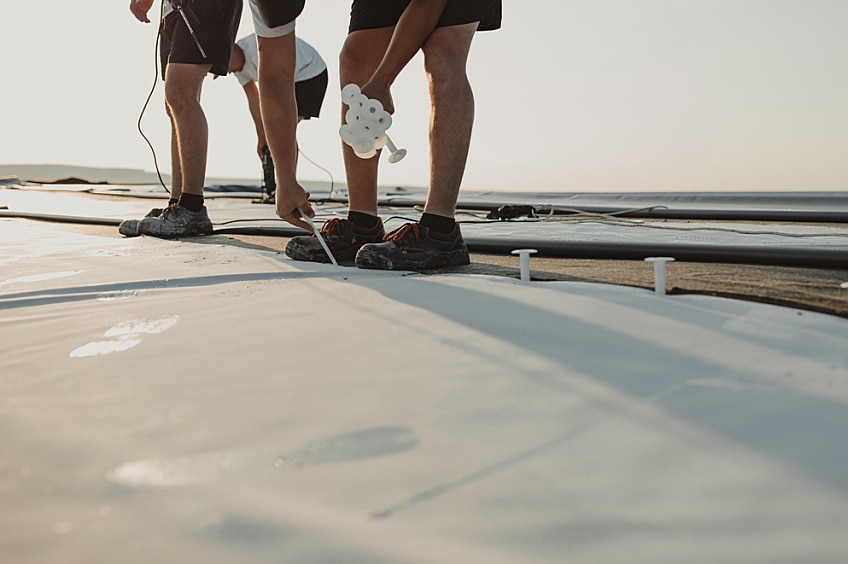When it comes to commercial roofing, the options are plentiful—but not every option is suited for every building. Each building has unique needs that factor into which types of roofing may be suitable for a given project. Here is an overview of what goes into a commercial roof as well as the material options available.
1. The Roof Deck
Commercial roof systems are installed over a roof deck. There are different types of roof decks, including:
- Metal
- Wood
- Lightweight insulating concrete
- Standard concrete
- Poured gypsum
- Tectum decks
The roof deck serves as the substrate for a commercial low-slope roof. The additional layers of materials that are installed on top of the roof deck make up the roofing system.
2. The Insulation and Cover Board
Insulation or cover board is often installed over the roof deck. Cover boards have insulating properties, can help provide protection against damage from impact or punctures, and can be used in a system that requires an ANSI/UL 790 Class A fire rating. (Check the UL directory for approved systems). They are also a common choice when roofing over the top of an existing roof.
Insulation board comes in a variety of options. Based on the thickness of the board and the number of layers installed, the end result will deliver different R-values for the roof system and the building. The higher the R-value, the better the system works to keep heat from entering or exiting the building.
3. The Finishing Touches
The roof membrane or coating is typically installed over the insulation or cover board. There are several different types of roof membranes or coatings to choose from, depending upon the specific needs of the project and the owner's preferences.
Single-Ply Membranes
Single-ply membranes are available in three different options:
- EPDM: Also known in the roofing industry as rubber roofing, EPDM has been in use since the 1960s. It's fairly easy to install and can be mechanically attached, adhered, or ballasted.
- TPO: TPO is a thermoplastic membrane that made its roofing debut in the 1980s. It has quickly grown to make up about 50% of the single-ply market. Available in an array of light colors with reflective properties, TPO is attractive to building owners interested in energy efficiency.
- PVC: PVC is a thermoplastic membrane introduced in the 1970s. It provides strong puncture resistance and can withstand exposure to many chemicals and greases. Weldable seams with bleed-out make it easy to tell when a weld was successful.
Asphaltic
Asphalt roofing systems are among the oldest and most trusted kinds of roofing system. Two of the most popular include modified bitumen and built-up roofing (BUR).
- Modified bitumen: This type of roofing generally consists of a base sheet and a cap sheet and can have one or more ply sheets installed between. Depending on the style of the sheet, installation options vary from torching to hot mop applied to adhesive applied to self-adhered.
- BUR: As one of the oldest asphaltic roofing systems, BUR consists of layers or plies of asphaltic sheets that are installed using hot asphalt. Additional sheets or layers are added until it reaches the desired number of plies.
Liquid Applied
Liquid Applied Coatings are becoming more popular as building owners look for solutions that can extend the life of a structurally sound roofing system and help increase time between tear-offs. Often referred to as coatings, there are multiple systems available featuring the following technologies:
- Acrylic coatings: These are exceptionally durable and ideal for coating over a variety of substrates. They offer reflectivity and excellent waterproofing protection.
- Silicone coatings: These coatings can protect against biological growth associated with ponding water, while also providing high reflectivity.
- Urethane coatings: These coatings are highly durable and provide strong resistance to physical impact and foot traffic.
- Fluoropolymer Resin coatings: PVDF coatings provide excellent flexibility with a tough finish that offers exceptional color stability. These coatings are often used for design work on roofs such as company logos.
- SEBS coatings: These thermoplastic coatings cure to form a monolithic rubber membrane. Their high flexibility can help withstand the expansion and contraction that may result from extreme temperature changes.
GAF has solutions to meet the needs of any commercial roofing project. Visit the GAF commercial roofing resources page to learn more about the solutions available or contact your local GAF territory manager to get started with your next commercial roofing project.

